Written By Patrick Brame
The prologue of Guillermo Del Toro’s 2015 film Crimson Peak begins with a white screen fading in on the disheveled, distraught, and bloodied protagonist, Edith, proclaiming, “Ghosts are real… This much I know.” Del Toro presents to the audience Edith’s first interaction with a ghost with a flashback of Edith’s mother’s funeral. On a stormy night, as young Edith weeps in her bed, the audible tick tock of a clock abruptly stops, with the shot lingering down a dimly lit hallway. A translucent, gaseous woman in a black dress slowly approaches and crawls into bed with her daughter. Edith’s mother returns to warn her, “When the time comes, beware of Crimson Peak,” then disappears from the room. As the camera exits Edith’s bedroom, retreating backwards down the hallway, Edith’s voice-over claims, “It would be years before I again heard such a voice. Or understood its desperate warning. A warning from out of time. And one I came to understand only when it was too late.” The end of the prologue fades in on a computer generated, aged book titled Crimson Peak, which opens to a black and white drawing of a town square, quickly transitioning into a colorful, moving filmic shot with the title card “Buffalo, NY 14 Years Later” (fig. 1). Foreshadowed within the three-minute prologue of Crimson Peak is a multifaceted presentation of time and the complex, unanchored understanding of our contemporary subjecthood and fractured spectatorship.
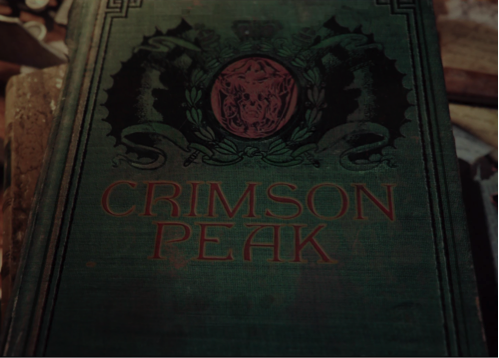
fig. 1 Crimson Peak the Book
Within Crimson Peak’s three-minute prologue, Del Toro presents three different temporalities, an adherence to a material and practical production design, a nostalgic desire for gothic narratives and aesthetics, and phantasmal characters enhanced with computer generated special effects. By blending these components together, Del Toro’s Crimson Peak represents a contemporary spectator caught in the midst of a radical transformation from a physical, whole spectator to a digital one, floating in a time-less cyber space. As a filmmaker, Del Toro has always favored the use of analog aesthetics, presenting a more realistic world to the spectator through material and practical production design, costuming, and make-up (perhaps ironically, considering all of his films fall within the fantasy/horror genre). In Crimson Peak, a gothic revival mansion serves as the primary setting and is a visual feast of production design. His emphasis on the analog, presenting physical, non-digital aesthetics and designs, immerses the viewer in the filmic world. What can Del Toro’s emphasis on a more analog, material aesthetic (a physical geography that holds a physical place in space), instead of utilizing a more digital one (a non-geography, a place without physicality) inform us about our present subject transformation?
Crimson Peak’s uncanny combination of materiality and immateriality functions as a reaction to a shift and/or transformation in spectatorship. Through the elaborate and lush material production design of Crimson Peak, the spectator is confronted with various instances of inorganic animation and doubling, eliciting the uncanny.1 The uncanny double becomes a prevalent motif throughout Crimson Peak: during pre-production, Del Toro and his crew built the primary setting from a highly detailed miniature model; the initial setting of a bright, modern Buffalo, NY juxtaposes a crumbling gothic mansion in a bleak and cold Cumberland, England; the two protagonists, Edith and Lucille, visually oppose one another; and the crimson red ghosts, presented as both physical and digital, inhabiting the mansion mirror the spectator’s own experience. The double, thus, becomes a site where the spectator is shocked into an awareness of a blurred and confused positionality: between a whole and physical spectatorship and a fractured digital one. The awareness of this in-betweeness occurs within the primary location of Crimson Peak, Allerdale Hall, a lush, tactile, gothic mansion. I will argue that this setting, where the spectator is made aware of their digital spectatorship, occurs within a material and monstrous feminine space that communicates not only the diegetic character’s psyche, but also, through Del Toro’s ghostly representations and Freud’s uncanny, the spectator’s confused spectatorial experience. The crimson red ghosts of Crimson Peak and Del Toro’s (re)presentation of them visualizes the contemporary spectator’s own dualistic experience.
The film’s aesthetic and narrative firmly position it within the gothic tradition. Literary and Victorian scholar Kelly Hurley observes the gothic “has been theorized as an instrumental genre, reemerging cyclically, at periods of cultural stress, to negotiate the anxieties that accompany social and epistemological transformations and crises.”2 Specifically, fin de siècle gothic offered “the spectacle of a body metamorphic and undifferentiated;…in place of a unitary and securely bounded human subjectivity, [it] is both fragmented and permeable.”3 The crisis of subjectivity within the gothic perceived by Hurley alludes to a similar fragmentation within filmic spectatorship. Therefore, the divided spectator positioned between the physical and the digital represented within a contemporary gothic film is not out of the ordinary. Crimson Peak continues these themes through its materially rich aesthetics and ghostly special effects.
Crimson Peak is a gothic romance set in the midst of burgeoning modernization in 1901. Fourteen years after her mother’s death, Edith, the daughter of one of the wealthiest industrialists in Buffalo, NY, traverses the bustling town square to have her latest manuscript read and hopefully published, insisting, in a self-reflexive nod to the film on the whole, it is not a ghost story, but rather a romance with ghosts. While revising her latest manuscript at her father’s office, Edith encounters Thomas Sharpe, an English entrepreneur seeking investments from her father to build his steam powered clay miner. In the midst of Thomas’ and Edith’s budding romance, despite her father’s wishes, we are introduced to Thomas’s envious sister Lucille. After Edith’s father mysteriously dies, Edith marries Thomas and moves with him and Lucille to their estate, Allerdale Hall, in Cumberland, England. Once Edith arrives, she begins to witness strange, crimson ghosts roaming the house, warning her of its inhabitants. The audience learns that the Sharpes have been serving Edith poisonous tea in order to gain her father’s inheritance. Unbeknownst to Edith, Thomas has married several women in the past for their fortune, who now roam the halls of Allerdale Hall. More shockingly, Thomas and Lucille have secretly had an ongoing incestuous relationship since their teenage years, all the while plotting and poisoning Thomas’ past wives for their inheritance. Through numerous clues revealing the mystery behind these specters, Edith learns that the house she has come to call home is the same Crimson Peak she was warned of by her specter mother. Learning of Thomas’ and Lucille’s true intentions, Edith refuses to sign over her inheritance, stabs Lucille, and with the help of Thomas, escapes her grasp. In the final scene, Thomas confesses to Lucille that he is in love with Edith. Lucille kills Thomas in a jealous rage and chases Edith throughout the house until Edith kills her with a shovel to the head.
The Material Double: Tactile Space and Digital Spectatorship
The most alluring aspect of Crimson Peak is its elaborate and eye-catching production design. With a unique medieval/gothic revival vision in mind for the interior of Allerdale Hall, Del Toro and production designer Thomas Sanders designed it from scratch. Sanders was inspired by Edward Hooper’s “The House by The Railroad” (which also influenced the house in Hitchcock’s Psycho).4 It is worth noting that the house, from its inception, was designed as a physical structure with its own geography. Sanders began by visualizing the house with Del Toro through illustrations, after which he designed a small, detailed and painted, to-scale model, which allowed Del Toro to explore how certain shots and camera movements could be accomplished. Sanders and Del Toro’s emphasis on the model’s detail, including miniature furniture, painted and wallpapered walls, light fixtures, portraits, and interior accents, distinguishes it from the more contemporary pre-productions practices of digital imagery. Then, they up-scaled the model, doubling the miniature original one exactly, into a studio sound stage. Because much of the film takes place within the house, Del Toro and Sanders wanted to create a space that felt like it was lived in (and where cast and crew would be comfortable working for six weeks) to obtain more realistic and therefore powerful performances from the cast.5
By designing and constructing the interior of the house from scratch, Del Toro could plan many of his shots before inhabiting the location and manipulate the house how he saw fit. Enhancing the immersive and organic nature of Allerdale Hall, many of the interior shots of the mansion utilize the structure and design of the house’s architecture to provide framing and create depth. For instance, when Edith encounters her first crimson ghost, Del Toro uses the design of the bathroom to create a sense of claustrophobia and anxiety, while framing Edith using the narrow, tall doorway from the outside (sharing the perspective of the specter).
Creating the interior of the mansion in Crimson Peak was a joint effort. Sanders focused on historical details and Del Toro adamantly insisted the house feel organic. The house itself becomes a malignant character, a living and breathing organism with a pulse. Del Toro’s intentions are twofold: first, as Del Toro suggests, “In Gothic, it [the haunted mansion] is a manifestation of the characters’ psyche or moral decay. Like our head – it is full of their demons and angels. Full of the past.”6 Lucille, thus, becomes tied to the mansion, connecting the deteriorating structure to her crumbling psyche. Second, because the house becomes an organic structure it therefore holds a temporality: it ages, decays, rots, and holds memories. The house represents the history and characterization of the Sharpe family – for instance, the clay pits in the cellar hold the sibling’s dark secret of Thomas’ murdered wives – while standing in for an era of cinema now longed for, where the analog amazed and immersed.
The nostalgic longing for a more analogic and immersive cinema results from the contemporary digital spectator experiencing “a severe nostalgia for time and history at the beginning of the modern period…in both theory and practice.”7 We have thus defined the “spatially absent” – “cyberspace” or “virtual” space – through nostalgia, engaging “analogies with our own conventions, conventions that force us, against the grain, to understand the spaceless in spatial terms.”8 The desire to create and be immersed within material, physical worlds like Allerdale Hall, stems from our inability to locate our physical bodies in an increasingly digital world. Del Toro’s and Sander’s decision to strictly use analog technology and techniques within an increasingly digitized industry situates Allerdale Hall allegorically to the spectator’s own positioning. The construction process and materiality of the gothic mansion, moreover, envelopes the spectator in the tactile simultaneously revealing their dualistic spectatorship between the physical and digital.
The dualistic nature of our contemporary moment is further represented in the juxtaposition between Allerdale Hall and Buffalo, NY. Del Toro presents Buffalo with a yellow tint, signifying a bright future with the emergence of modernization (fig. 2). The town square is populated with merchants and salesman, the wealthy are driving new motorcars, railroads – signifying expansion, speed, and power – are being constructed throughout the city, electric lights populate homes and streets, and Edith’s father’s office is filled with architects and models of city towers. Edith is strongly linked to the modernized Buffalo setting, often wearing yellow tinted dresses. In comparison, when Edith moves with Thomas to Allerdale Hall, the landscape is gray, bare and desolate, surrounded by Thomas’ failed mining machines (fig. 3). Contrasting a dilapidated Allerdale Hall with a modernized Buffalo situates the former as lost in time, a ghost in itself. This juxtaposition also gains a nuanced quality as well. The material and practical nature of the mansion’s interior displaces it outside the present moment, while contemporary Hollywood genre films typically favor digital environments and design over the more realistic. Hence, the house in Crimson Peak represents a rotten and horrific past leading to infection and decay while, conversely, it represents a nostalgic desire for pre-digital cinema and a physical, whole spectator.
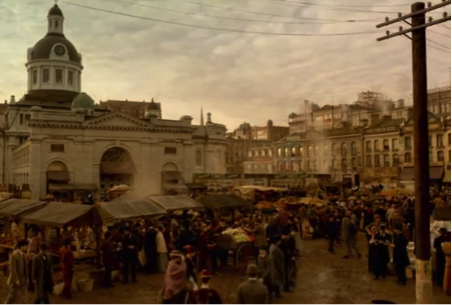
fig. 2 Del Toro’s Buffalo
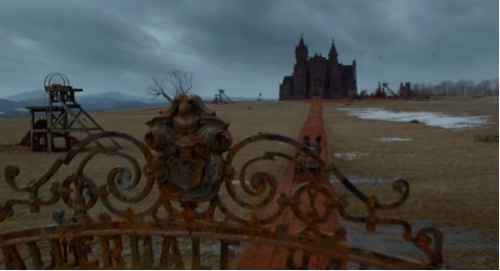
fig. 3 Allerdale Hall
Pictures of Buffalo and Cumberland
As previously stated, the nostalgic longing for more materialistic immersive media and narratives seems like a common response when confronted with the contemporary moment. In the case of Crimson Peak, the nostalgic production design and narrative comforts the spectator undergoing, as Anthony Vidler notes in “Warped Space,” a spatial and temporal crisis. Human subjectivity presently inhabits a space no longer meant for them. Instead, “science and information have apparently constructed a world that has little need of the human in the first place.”9 This new space of science and information, better defined as “no-space,” has no material dimensions or visible essence; for lack of a better term, it is space-less. As Scott Bukatman affirms in Terminal Identity: The Virtual Subject in Postmodern Science Fiction, these “spaces” have become “a function of telematics culture and the expansion of new technologies that substitute for experiential reality – the digital has replaced the tactile.”10 Indeed, how can a string of 0’s and 1’s looped around a computer screen create space?
Per Vidler, while information may be represented spatially, the “information itself seems to have no inherent spatiality.”11 Vidler confirms Bukatman’s contention in his analysis of postmodern science fiction narratives that attempt to cognitively map this new digital space. Bukatman posits that “Invisible spaces now dominate, as the city of the modernist era is replaced by the non-place urban realm and outer space superseded by cyberspace.”12 Following Vidler’s argument, if bodily humans are caught between modernism’s conception of space and the new cyberspace, a space where physicality is no longer necessary, what happens to the filmic spectator?
Space and identity have always shared a close relationship. As Vidler contends, “The humanistic subject in perspectival space, the modern subject in montage space: these tropes of interpretation have, with many variations, come to stand for historically defined identities if not experiences.”13 In conjunction with Vidler, postmodern media theorists N. Katherine Hayles and Jordan Crandall reveal that the relationship between surveillance technologies that strongly inform the digital “no-space” – specifically RFID (Radio Frequency Identification) – and subjectivity are intricately intertwined. RFID technologies, such as GPS software in cell phones and chips in credit cards, transform our environments into “animated” spaces, consequently altering the “perceptions of human subjectivity”14 through “the technological unconscious.”15 RFID technologies, then, transform the physical environment and encase the subject within the digital, therefore altering “conventional ontological categories” of subjectivity, and, importantly, the spectator’s perception and ‘seeing.’16 Extending Hayles’ and Crandall’s arguments to humans’ semiotic faculties, urban theorist William J. Mitchell asserts that electronic and digital tracking technologies have altered our ability to construct meaning. The transition to an ever-increasing digital environment confuses the ways in which we create and understand our perceived surroundings. Instead of coupling physical information and knowledge with physical objects, the invasion of the digital disrupts our meaning-making receptors.17 In other words, digital and electronic technologies of interactivity, immersion, and surveillance have altered the many ways we understand and ‘see’ the world.
From the literature, we can subsume, then, that there is some form of spectator transformation in progress. Digital media theorist David Savat proposes that “subjectivity… changes depending on the various forces and pressures by which it is produced and by which it produces itself.”18 Digital technologies of interaction, perception, and surveillance, such as RFID, have “affected and effected” the subject’s understanding of the self. The digital environment, the space created by these technologies, envelopes the subject and cinematic spectator subsequently altering how the world is seen and perceived.19 Vidler elaborates,
…the infinite mutability, the seemingly endless permutations and rotations of digital constructions, the speed of virtual travel within the image, not to mention the complexity of the networks of communication themselves, all lead to the suspicion that some transformation in subjecthood is under way.20
If there is indeed a new form of subjectivity on its way, a new perspective and way to perceive the world, how does one experience this transformation and new mode of ‘being?’ If the relationship “between image and experience” has been “changed beyond recognition within the processes, if not the outer forms, of spatial design,” how is one able to explore and elaborate on this new subjectivity? How can one illuminate and expound upon the fractured spectator placed in front of a film screen?
The (Im)material Double: Lucille and Allerdale Hall
The transformation from a modern, physical subject to a digital, time-less one visually manifests itself in Crimson Peak’s materially lush production design. This not only occurs within the confines of Allerdale Hall, but also from dichotomous character traits and how the characters relate to the gothic mansion setting. Del Toro and Sanders accomplish this by instilling the production design with human characteristics and vice versa, strongly eliciting Sigmund Freud’s notion of the uncanny. The uncanny, or unheimlich, refers to “everything that was intended to remain secret, hidden away, and has come into the open” evoking “fear and dread.”21 The uncanny, then, is experienced when the subject is confronted with “old, discarded beliefs,” such as the double, or “doppelganger.” Primitively, the concept was thought to provide “insurance against the extinction of the self,” only to eventually represent the “uncanny harbinger of death.”22 However, Freud distinguishes between the uncanny one experiences in reality from the one that occurs through fiction.
Within a fictional setting, the uncanny becomes “much richer than what we know from experience; it embraces the whole of this and something else besides, something that is wanting in real life.”23 This is made possible if the author creates a common reality, adopting “all the conditions that apply to the emergence of a sense of the uncanny in normal experience; whatever has an uncanny effect in real life has the same in literature.” The uncanny originating from fiction, moreover, has the potential to develop a more intense and intimate uncanny sensation than one from reality: “The writer can intensify and multiply this effect far beyond what is feasible in normal experiences; in his stories he can make things happen that one would never, or only rarely, experience in real life.”24 Adhering to classical Hollywood editing, Del Toro contextualizes his gothic romance within a historically accurate setting and place in time. This, in addition to the materialistic interior of Allerdale Hall, creates a reality where the spectator can find common traits and relationships. The uncanny elements confronting the spectator within the fictional and materialistic gothic mansion of Crimson Peak (i.e. aesthetics increasingly being “discarded” in favor of the digital) reveals the spectator’s desire and ‘wanting’ for their own subjective positionality and ‘being.’
Within the gothic genre, the uncanny holds a prominent place. Lisa Hopkins has argued “the classic genre marker of the Gothic in film is doubleness, for it is the dualities typically created by the Gothic that invest it with its uncanny ability.”25 The doubleness of Crimson Peak is found in many forms, however there are two ways of particular interest here. In the first, the spectator recognizes their own digital spectatorship in the mansion’s specters, eliciting the uncanny as an “effect of a disturbed present, a present affected by massive upheaval and transformation. It is less the revenance of a lost or suppressed human nature (against the artifices of modern culture) and more a product of scientific and technical innovation.”26 Second, the dueling characters of Edith and Lucille represent a doubling that “creates polarities: extreme good is opposed to extreme evil, extreme innocence to extreme power, and very often extreme youth to extreme age.”27 The polar characteristics of Edith and Lucille are represented in an early scene at a public park (fig. 4). After giving Thomas the latest draft of her manuscript, Edith walks over to Lucille who is snipping cocoons from a tree branch. Standing next to Lucille, Edith notices and inquires about all the dead butterflies at her feet. To which Lucille responds, “They take their heat from the sun and when it deserts them… they die.” Del Toro frames this shot with the two characters side by side in stark contrast, visualized through their polar fashion tastes. Edith is seen wearing a bright white, pink, and tan dress, while Lucille is dressed all in black with a single red rose on her chest. Lucille then explains that at Allerdale Hall, all they have are black moths, which she describes as “formidable creatures.” While the two are set up as opposites through their fashion, Del Toro also links the characters insectually: Edith as the butterfly and Lucille as the black moth. The implication is that Lucille, the formidable black moth, will slowly capture and kill the beautiful and innocent Edith.
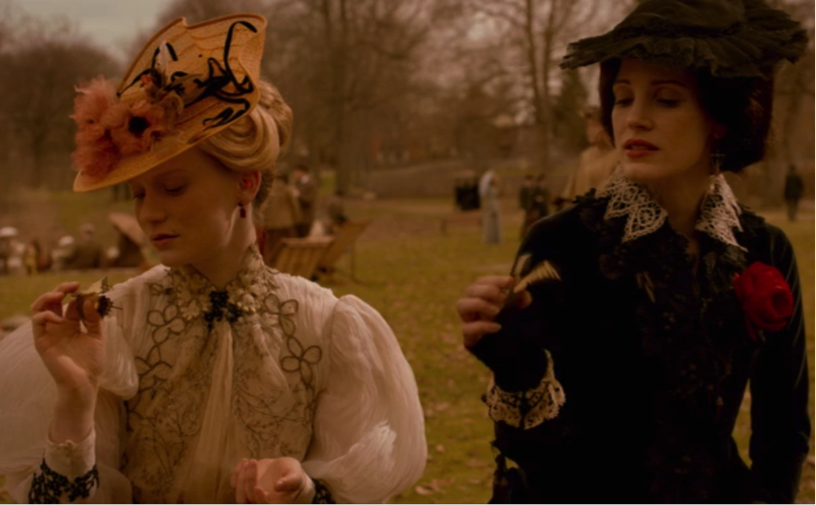
fig. 4 Edith and Lucille
The uncanniness of Crimson Peak is further induced through Lucille’s mimesis of the mansion, which is also tied to her connection to the black moth. Once the film’s narrative transitions to Allerdale Hall, Lucille is seen wearing only one dress: a velvety dark teal gown, with black frills around the neck as well as tiny teeth-like spears (fig. 5). The dark teal color of the dress is replicated throughout the mansion’s walls and furniture. The black frills around her neck resemble the black moths that cover the walls of the nursery where Thomas and Lucille spent much of their childhood. The teeth-like spears are the same shape and length of the teeth outlining the archways of the halls.
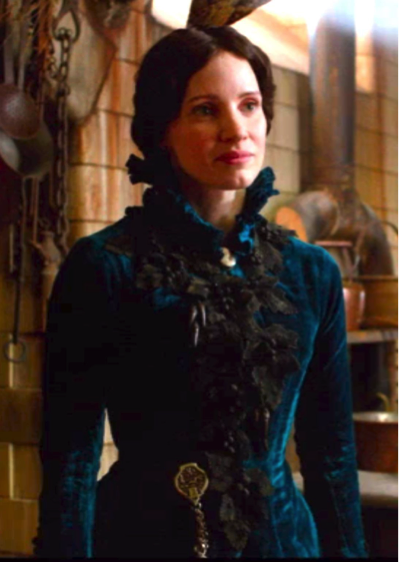
fig. 5 Lucille’s Dress
As Edith becomes increasingly distressed by her encounters with the supernatural, she seeks comfort from Thomas on their darkly colored, Victorian style love seat, which closely resembles a black moth with its wings expanded. When Edith embraces Thomas on the seat, the furniture appears to have massive black wings, resembling a black moth enveloping and consuming Edith. Discussing the animation of the inorganic, Spyros Papapetros utilizes Raoul France’s “universal” theory of mimicry. France’s theory suggests everything from tiny insects replicating dead leaves, crayfish emulating seaweed, and Italian soldiers dawning “froglike suits – all natural bodies sought to imitate something other than what they originally were. In order to continue living, organisms had to act as inanimate objects pretending they were dead.”28 Lucille mimics the interior of the mansion, becoming one with the walls and fixtures. The mimicry of Lucille within Allerdale Hall produces an uncanny experience for the spectator as she, a physical, organic human, appears from the tactile walls of the mansion as if she were part of its very structure. Thus, Lucille’s ability to simultaneously be both organic and inorganic, blurring the boundary between her physical presence and the mansion, represents the spectator’s own disoriented perception and spectatorship.
Del Toro clearly establishes, specifically through narrative elements and Lucille’s clothing, Allerdale Hall as a feminine space. Not only does Lucille mimic the interior décor and design, but certain spaces are coded as feminine though various narrative and thematic components: The Hallway, The Kitchen, The Clay Pits, and The Foyer. After transitioning to Allerdale hall after the first act, the majority of the narrative takes place within these four spaces, which coincides with crucial narrative revelations to Edith’s experience and investigation. These spaces are closely tied to Lucille and a perverse femininity while also exhibiting organic characteristics. Lucille’s mentality and emotions are manifested in these places, tying her to Allerdale Hall (fig. 6).

fig. 6 The Space of Crimson Peak Mansion
The feminine has a long and sordid history within the gothic genre. Borrowing from supernaturalist author William Hope Hodgson, Kelly Hurley highlights the fin-de-siècle gothic woman as one of the many sites that embodies the “abhuman.” The “abhuman” is “characterized by its morphic variability, continually in danger of becoming not-itself, becoming other. The prefix ‘ab-’ signals a movement away from a site or condition, and thus a loss. But a movement away from is also a movement towards – towards a site or condition as yet unspecified – and thus entails both a threat and a promise.” Analogously, the gothic literature at the fin-de-siècle characterized the female body as “fluctuating” and “incomplete,” in the midst of a transformation moving towards a new sense of self and mode of perception.
Embodied by the gothic woman, the “abhuman,” is similar to the contemporary spectator’s fractured self. The “abhuman” is in a constant state of irregularity, continuously adapting and shifting to a new form of ‘being.’ Similarly, the spectator’s self is trapped between a radical transformation and “becoming.” The contemporary spectator moves towards an “otherness” of ‘being’ and ‘seeing.’ Informed by the fin-de-siècle gothic and Hurley’s analysis, I will argue later that the space of Allerdale Hall becomes a monstrous site of femininity where the “abhuman” emerges through the (re)presentation of the crimson red ghosts. This mirrors the spectator’s own fractured and confused subjectivity and way of ‘seeing.’
While the mansion has many hallways connecting many various rooms, there is one hallway of central importance: the Hallway is located on the second floor, paralleling Thomas and Edith’s bedroom (fig. 7). The Hallway is darkly lit, with only one small window at the end. But what distinguishes this hallway are the repeating archways outlined with elongated, sharp teeth. As stated in the special features, Del Toro wanted the hallway to repeat in such a way that it would appear to be out of focus for the viewer, creating anxious confusion.29
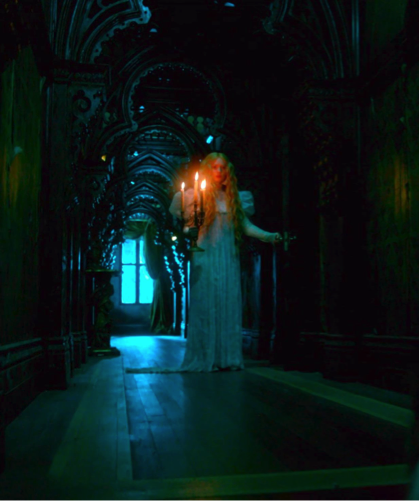
fig. 7 Mansion Hallway
Due to its design, and Del Toro’s camera movements, the spectator feels as though The Hallway is closing in on its subject, swallowing them whole. The Hallway is where Edith is confronted with two different crimson ghosts: the first from a closet and the second emerging from the floor. Using a Freudian lens, the teeth protruding from the repeated archways represents the vagina dentata, i.e. fear of castration. This explains why Thomas is never seen traversing this particular passage, only Edith and Lucille. Thus, Del Toro establishes The Hallway as a grotesque feminine space through its design and inhabitants.
Next, The Kitchen and The Clay Pits, though vastly different, are all practical. The Kitchen is so realistic that it is a hands-on working kitchen.30 Early in the film, the kitchen, the heart of any house, is established as Lucille’s space: she cooks the meals, brews the poisonous tea, and red clay crawls down its walls when Lucille is distraught or excited. In addition, Edith has numerous secrets revealed to her within the space of the kitchen. It is in the kitchen where Edith learns that Allerdale Hall is nicknamed Crimson Peak, and discovers and steals a mysterious key from Lucille. Moreover, in the space of the kitchen, the audience learns that both Thomas and Lucille are poisoning Edith’s tea.
The Clay Pits, on the other hand, represent the membrane and guts of the house, where all secrets are buried and revealed (fig. 8). Located in the basement of the house, it contains eight separate pits filled with liquid clay and dead bodies, with pipes and waterways running through the floor and walls transporting red liquid. Thus, the pits have a strong connection to preserve and monstrous womb: it is dark, wet, and gives birth to Edith’s revelations concerning the Sharpe siblings. The design, structure, and aesthetics of Allerdale Hall begs spectators to lean in closer, to immerse themselves deeper into Crimson Peak, and to experience Lucille’s connection to Allerdale Hall, a connection visualized through materiality and practical effects and aesthetics.
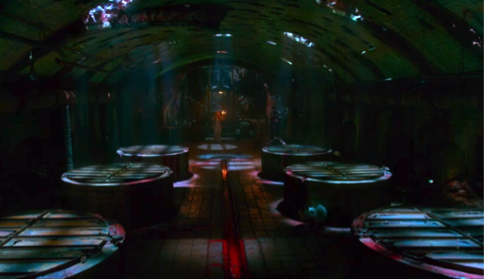
fig. 8 Clay Pits
The character of Lucille Sharp shares a strong relationship to the mansion, consequently bridging a connection between Allerdale Hall and the spectator. When Lucille’s emotions are high, eventually becoming manic, the house too begins to come undone. Through Edith’s perspective, the spectator is gradually introduced to the exterior, and later, more significantly, the interior of the home. After the funeral of Edith’s father and marriage of Edith and Thomas, the screen fades in on the gates of Allerdale Hall with Edith and Thomas entering by horse and carriage. As the camera pans up, displaying the landscape of Allerdale Hall, we are presented with grey skies, a barren landscape with dying trees and grass, littered with Thomas’ failed machines.
As the scene continues, Thomas and Edith enter Allerdale Hall with the camera following. The shot opens up to the expansive foyer, with a decadent three-story stairwell on the left lined by various portraits. Three stories above, the ceiling has a gaping, rotting hole allowing precipitation, sunlight, and dead leaves to constantly fall through the middle. This causes Edith to remark, “It’s even colder inside than out.” Much like Lucille’s and Edith’s relationship, the house at first appears beautiful and comforting, but reveals itself as cold and rotting from within. Thomas explains to Edith that the precipitation and cold weather have made the upkeep of the home “impossible,” in addition to the clay mines below rotting the wood and pulling the house down to the earth. Thomas’ words here illuminate our own fears of not only the digital but the finitude of physical, material objects and bodies. To illustrate Allerdale Hall’s deterioration, Thomas steps on some loose floorboards, causing the red liquid clay to rise from below. Entering the house with Edith, as husband and wife, we see the first sight of the red clay oozing from the house, like blood from a pressurized wound (or Lucille’s broken heart).
Later, after Edith has settled in, she and Thomas are sitting by the fire when a loud “ghastly” wind blows through the home, causing Edith to embrace Thomas in horror. Thomas explains to Edith that when the wind picks up, the chimneys create a vacuum, which makes “the house breathe.” The shot abruptly cuts to a new one framed through a keyhole, where we learn coincidentally, that Lucille has been spying on them the whole time. Del Toro’s cut links the breath of the house to Lucille’s concern over Thomas and Edith’s relationship. Similarly, while in the kitchen, Edith stealthily removes a key from Lucille’s key ring in the hopes it will unlock further mysteries of The Sharpe family. Del Toro frames the shot with Lucille in the foreground tending to the fire (with copious amounts of red clay running down the walls) and Edith in the background. Once again, the wind blows and the lungs of the house exhale signifying Lucille’s apprehension, and growing suspicions of Edith.
The last tie between Lucille and the house concerns the red clay, the blood of the house. Many times throughout the film we see the liquid red clay running and oozing down the walls of the house. When the audience witnesses this, i.e. when Del Toro reveals the organic nature of the home, it is during or immediately followed by an emotional outburst from Lucille. As mentioned above, the first time we see this happen is when Thomas puts pressure on one of the floorboards minutes after entering the house with his new love, Edith, signifying a disruption between Lucille and her brother and lover. Following the above-mentioned scene, Thomas gives Edith a quick tour of the kitchen until Lucille enters from the opposing doorway. Here again, we see thick trails of red clay running down the walls. Later, in the kitchen, after Edith and Thomas have returned from a night away, Lucille becomes furious at Edith for spending the night with Thomas and leaving her alone in the house. Del Toro once again emphasizes the red clay running down the walls highlighting Lucille’s emotional state.
After Edith learns of Thomas’s past marriages, and Lucille being committed for killing their mother, behind her, in the background, the red clay begins to run quickly down the walls of the foyer, cutting back and forth between Lucille and Edith. Lastly, and most importantly, after Lucille kills Thomas in a fit of jealous rage, she manically runs after Edith, knife in hand, down the stairs of the foyer. The corners of the foyer have thus begun to pour clay down the walls, while Lucille is fleeting down the stairs.
Through allegory, Del Toro allows the spectator to experience Lucille’s emotions and ‘being’. Through the representation of the mansion we learn of and feel her emotions through visuals. Del Toro has attached Lucille’s ‘being’ to the analog house of Crimson Peak. While some might argue Thomas is as much attached to the house as Lucille, due to Thomas’ positioning throughout the film, i.e. he is only ever seen in bedrooms, his workshop in the attic, and outside working on his machine, he does not share a clear connection to the house, while Lucille is repeatedly tied to it. Del Toro has consequently feminized the interior space of the house where the spectator is consequently immersed and experiences a nostalgic desire for a pre-digital spectatorship. Represented through the crimson red ghosts, the twisted feminine interior of Allendale Hall becomes the site of an encounter between a physical, material mode of viewing and a digital one.
The Digital Double: Crimson Red Ghosts
Allerdale Hall’s coming undone, and Lucille’s simultaneous mental break, begins with the introduction of Edith. This is signified through her yellow clothing as an embodiment of modernization and technological innovations within the aging and deteriorating confines of the home. Much like Edith’s disruption of Allerdale Hall and the Sharpe’s lifestyle, Del Toro’s representation of the crimson ghosts similarly unsettles the spectator’s understanding and sense of place within the ever-expanding emergence of digital technologies and spaces. For Del Toro, the figure of the ghost and a film’s environment have a strong relationship with one another. “Film architecture is beautiful because it’s ephemeral. Film is nothing but the trapping of things that are no more. Film is our communion with ghosts. Our pinned butterfly collection.”31 It would seem the film, not just Allerdale Hall, becomes an object lost in time, trapped between two temporalities and ‘beings’: the material and the digital.
Del Toro emphasizes this temporal relationship further with his design and representation of the crimson red ghosts. He created the ghosts to be both physically material, i.e. having a human stunt worker in a practical effect ridden crimson red body suit, and digital in order to illustrate their translucency (fig. 9). The addition of digital effects helped create the translucency and transparent quality of the specters. In other words, the ghosts themselves become an uncanny double, both material and digital (fig. 10). Del Toro’s ghosts, thus, cross the digital/analog border in an attempt to capture a specific experience. “Mixing physical effects and digital translucency allows us to capture a unique presence. Specters halfway between the physical and the ethereal. Not in the future and not in the past.”32 Del Toro’s dualistic ghosts of Crimson Peak adhere to Bukatman’s definition of “terminal identity:” “[It] is a form of speech, as an essential cyborg formation, and a potentially subversive reconception of the subject that situates the human and the technological as coextensive, codependent, and mutually defining.”33 This identity, like the “abhuman” embodied in the gothic feminine, is a transitional form of ‘being,’ where the physical and the digital intersect. Hence, Del Toro’s ghosts represent an impermanent state, a temporality without an anchor, lost in time and place, much like the contemporary splintered spectator.
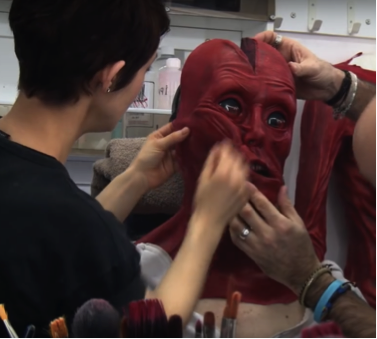
fig. 9 Material Ghost
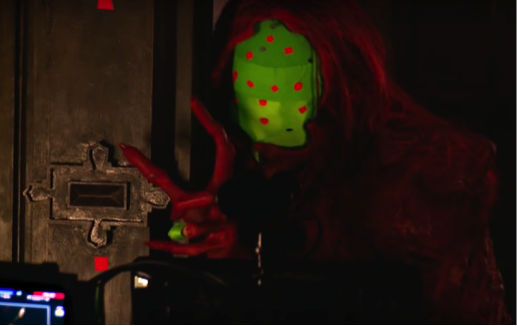
fig. 10 Digital Ghost
The ghosts found within Crimson Peak, who attempt to warn Edith about the Sharpe’s true intentions, reflect back to the spectator a budding digital mode of perception. According to Vidler, the emergence of this new subjectivity is closely tied to Lacanian psychoanalysis, specifically the mirror stage. Instead of a mirror constructing and reinforcing a subject’s self, Vidler insists the new mirror is not a mirror, but a screen. “This new mirror, which is more of a screen than a reflective surface, is, I believe, in the process of creating an imago that was hardly imaginable…in 1936.”34 The screen, for Vidler, creates “a refusal of reflection…and of resignation” where the “baby… is aware somehow that in looking at itself, and denied its desire to capture the face of the Mother, it is committed to a split identity…but as two imagos…blurred and morphed into a distorted physiognomy that is far from transparent or clear, but rather opaque and translucent.”35 The spectator of Crimson Peak is similarly confronted with their own warped identity and mode of ‘seeing’ through the filmic encounter with the crimson red ghosts, a blending of physical and digital, mirrored back to the fractured spectator (fig. 11).

fig. 11 Composite Ghost
The ghosts of Crimson Peak, who similarly flow in and out of space and visibility, are stuck between identities and ‘being,’ dead or alive. This phenomenon is represented in Thomas’ ghostly return to aid Edith in killing Lucille. Thomas’ specter is similarly created using both the physical actor and digital effects to enhance his ghostly appearance. After striking two deathly blows to Lucille’s head with a shovel, Edith approaches the recently deceased Thomas, caressing his translucent face, only to pass right through it. Once again, Del Toro complicates the material/digital dichotomy through Edith, a signifier of technological advancements, as well as a physical body confronting the material/digital presentation of Thomas’ specter. Consequently, the film screen, the window (or mirror) we view the filmic world through, reflects the spectator’s own dualistic experience through Thomas and the crimson ghosts, subsequently representing “the operations of new technologies and their hallucinatory, virtual effects.”36 The spectators arguably witness the present moment, a double of their own spectatorial experience. Thus, the emergence of the crimson ghosts within the gothic setting of Allerdale Hall hauntingly mimics the emergence of the spectator’s own digitality.
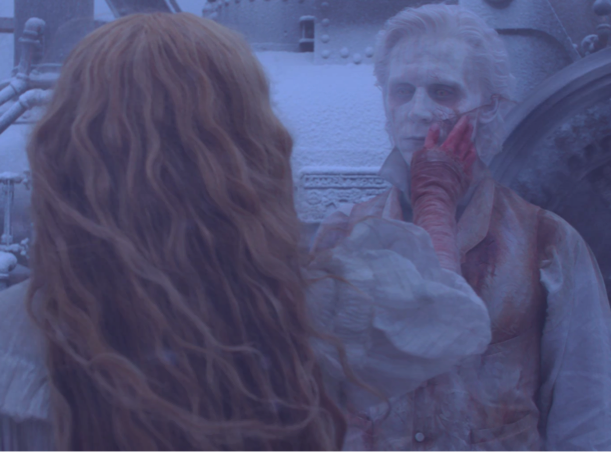
fig. 12 Edith Caresses Thomas’s Ghost
The gothic aesthetic of Crimson Peak and the intense confrontation of the digital subject with the uncanny is no accident. As Fred Botting suggests, within gothic horror “the collapse of boundaries separating reality and fantasy, fiction and life, a psychological condition associated by Freud with the uncanny, has become generalized. No one, its seems, is immune from its effects.”37 Furthermore, because the digital spectator is lost in space, in “a matrix, a web, a space of no time and no place, with a corresponding intimation of historical impasse, of the blockage of modernist progress,” they are consequently stuck between temporalities.38 The spectator experiences the filmic space, and any filmic space for that matter, through a screen where it “has no history properly speaking – it implies no way forward and no way back – and is thus suspended out of time.”39 Not only do the ghosts of Crimson Peak represent the digital subject through an uncanny experience, but the film as object does as well.
Moving from the more materialistic aspects of Crimson Peak to the more digital, illustrates, like the film, the transformation from a modern, physical spectator to a free floating, time-less digital one. The material production design and aesthetics of Crimson Peak inform and produce the spectator’s affective sensation experience of the uncanny through doubling and inorganic animation, subsequently jarring them into an awareness of their current, fractured spectatorship, caught between the physical and digital. The site of the spectator’s dualistic experience becomes a place of ‘becoming’ made possible through affective aesthetics and the blurred boundary between physical and digital effects. The spectator’s encounter with the double through Crimson Peak’s material aesthetics, character (re)presentation, and the crimson red ghosts produces a subjective and spectatorial awareness of a splintered identity as well as the seed of a new ‘becoming.’
The spectator’s awareness and burgeoning new subjectivity takes place within the filmic world of Crimson Peak, specifically the space of Allerdale Hall, Lucille’s domain. Lucille’s relationship with Allerdale Hall informs the spectator they are immersed in a corrupted feminine space. With the double, particularly the material/immaterial crimson red ghosts, emerging within a feminine space, Crimson Peak follows the gothic tradition of the “fragmented and permeable” “abhuman” embodied and emergent within the feminine. Moreover, the mansion is physical and material, yet it bleeds and breathes blurring the boundary between the inorganic and organic, which strongly alludes to the spectator’s own confused understanding of their own spectatorship.
The doubling of Crimson Peak – Del Toro and Sanders’ pre-production model, Edith and Lucille, and tactile aesthetics against immaterial, digital effects – within a physical and material space jolts the spectator into an awareness of their unstable and fractured spectatorship. The anxiety resulting from this consciousness causes a nostalgic longing for pre-digital spectatorship, where the spectator was whole, and held a physicality. The spectator retreats to the nostalgia of the pre-digital, to ‘return’ to the moment of wholeness, of unity, where ‘being’ and ‘seeing’ was anchored, and fixed purely to the physical and material. However, during these moments of the double, the spectator must withhold this nostalgic urge to be swept away in its comfortable arms, while still maintaining a necessary sense of historical connection to the pre-digital. As Edith proclaims, ghosts are indeed real. Trapped in between time and space, their experience mimics the spectator’s experiential limbo. And just like the red ghosts of Crimson Peak, spectators’ nostalgic longing for pre-digital experiences threatens to suspend the progress toward a new sense of self and spectatorship indefinitely.
- Sigmund Freud, The Uncanny, Translated by David McLintock (New York: Penguin Books, 2003). ↩
- Kelly Hurley, The Gothic Body: Sexuality Materialism, and Degeneration at The Fin De Siècle (Cambridge: Cambridge University Press, 2004), 5. ↩
- Hurley, 3. ↩
- Crimson Peak, directed by Guillermo Del Toro (2015; Universal City, CA: Universal Studios, 2015), Bluray. ↩
- Del Toro, Crimson Peak. ↩
- Del Toro, Crimson Peak. ↩
- Anthony Vidler, Warped Space: Art, Architecture, and Anxiety in Modern Culture (Cambridge: MIT Press, 2000), 235. ↩
- Vidler, 236. ↩
- Vidler, 235. ↩
- Scott Bukatman, Terminal Identity: The Virtual Subject in Postmodern Science Fiction (Durham: Duke University Press, 1993), 107. ↩
- Vidler, 235. ↩
- Bukatman, 6. ↩
- Vidler, 243. ↩
- Katherine Hayles, “RFID: Human Agency and Meaning in Information-Intensive Environments,” Theory, Culture, and Society, Vol. 26(2-3) (2009): 48. ↩
- Hayles, 49. ↩
- Jordan Crandall, “The Geospatialization of Calculative Operations: Tracking, Sensing and Megacities,” Theory, Culture and Society Vol. 27(6) (2010): 69. ↩
- William J. Mitchell, Me++: The Cyborg Self and The Networked City (Cambridge: MIT Press 2003), 17. ↩
- David Savat, Uncoding the Digital: Technology, Subjectivity and Action in The Control Society (New York: Palgrave Macmillan, 2013), 77. ↩
- Savat, 78. ↩
- Vidler, 243. ↩
- Freud, 132, 123. ↩
- Freud, 154, 142. ↩
- Freud, 155. ↩
- Freud, 156. ↩
- Lisa Hopkins, Screening The Gothic (Austin: University of Text Press, 2005), xi. ↩
- Fred Botting, Limits of horror: Technology, bodies, Gothic (Manchester: Manchester University Press, 2008), 7. ↩
- Hopkins, xi. ↩
- Spyros Papapetro, On the Animation of the Inorganic: Art, Architecture, and The Extension of Life (Chicago: University of Chicago Press, 2012), 223. ↩
- Del Toro, Crimson Peak. ↩
- Del Toro, Crimson Peak. ↩
- Del Toro, Crimson Peak. ↩
- Del Toro, Crimson Peak. ↩
- Scott Bukatman, 22. ↩
- Vidler, 245. ↩
- Vidler, 245. ↩
- Botting, 10. ↩
- Botting, 6. ↩
- Vidler, 246. ↩
- Vidler, 246. ↩
